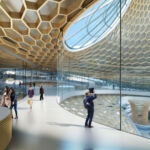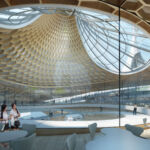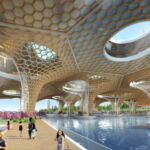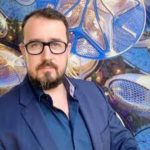Sustainable Vision: Yeouido Park Transformed by Manta Ray
Project's Summary
Title: The Manta Ray Project: A Vision for a Sustainable Yeouido Park
Yeouido Park, located on the banks of the Han River in Seoul, is set to undergo a transformative project known as the Manta Ray. The project, developed by Vincent Callebaut Architectures, aims to turn the park into a sustainable and innovative urban space that embraces nature and promotes ecological balance.
The main focus of the Manta Ray project is to enhance the park's natural irrigation system by creating an ecological forest of willow trees. This includes the development of a marsh-like filtering strip of plants along the riverbanks, which will serve as a natural barrier against flooding. By implementing this permeable landscaping, the project seeks to restore the park's original scenery and make it one of Seoul's most revered tourist attractions.
The ambitious plan for Yeouido Park revolves around four biomimetic projects, each characterized by densely vegetalized architecture. These projects are interconnected through fruit and vegetable gardens and a cable-stayed pedestrian bridge, creating a harmonious blend between urban infrastructure and nature.
The first core of the project, Yeoui-Naru, involves the construction of a floating ferry terminal on the Han River. Designed to adapt to rising waters during seasonal floods, the terminal will serve as a landmark for the entire project. It will offer cultural spaces that showcase the history and development of the river, while also facilitating river transit for residents.
The second core, Yeouijeong, focuses on revitalizing the riverbank by reintroducing terraces, pedestrian paths, bicycle lanes, and an amphitheater. This area will provide spaces for traveling bars, such as barges or tiny houses, enhancing the park's recreational offerings.
Yeoui Terrace, the third core, aims to develop the upper ground of the park along Yeoui-Dong road. This section will be lined with cherry blossom trees and will house shops dedicated to local products, fish and shellfish restaurants, and organic farmers' markets. Direct connectivity to the subway line ensures easy access for both locals and tourists.
The fourth core, Ari Cultural Center, will serve as a cultural complex featuring temporary and permanent exhibitions, a science center, and creative workshops for children. This center will further enhance the park's status as a cultural hub, attracting visitors of all ages.
The Manta Ray project's design for the Yeoui-Naru floating ferry terminal is inspired by the geometry of a manta ray. The terminal is suspended above the marina and gardens, offering unobstructed views of the Han River and Yeouido Park. The terminal comprises three levels, including panoramic floating dikes, programmatic uses inside the upper building, and an observation deck with a rooftop orchard.
The project places a strong emphasis on eco-friendly design, safety, and technical planning. The ferry terminal incorporates renewable energy sources such as solar, wind, biomass, and hydrokinetic turbines, ensuring the facility's complete energy autonomy. The use of locally sourced cross-laminated timber and environmentally friendly materials further contributes to the project's sustainability goals.
The Manta Ray project exemplifies Seoul's commitment to investing in soft infrastructure that fosters social cohesion and community engagement. By embracing nature and renaturalizing river banks, the project creates new opportunities for social innovation, urban farming, and resilience against climate change.
As the Manta Ray project takes shape, Yeouido Park is poised to become a symbol of the symbiotic relationship between urban dwellers and the natural environment. Through its sustainable design and integration of natural elements, the project aims to create a vibrant and resilient urban oasis that will be cherished by both locals and visitors alike.
Read also about the Canal Station: Blending History and Modernity in Architectural Design project






